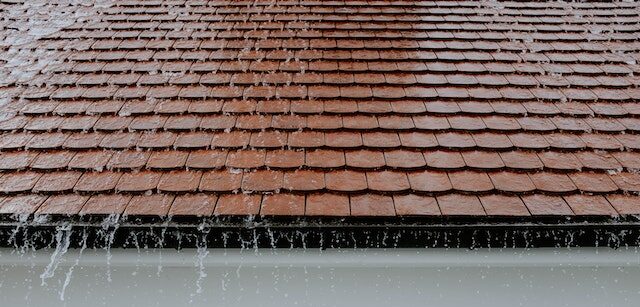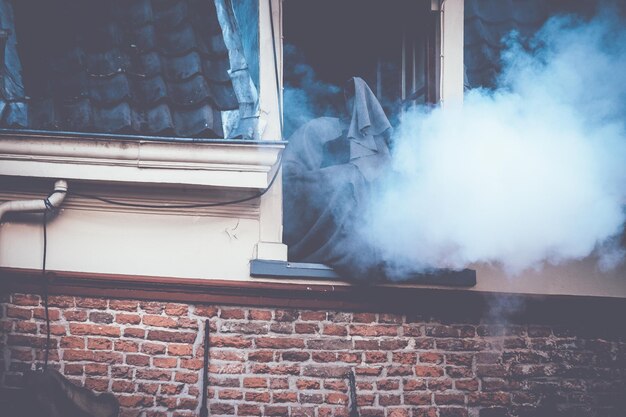Smoke removal and remediation are important parts of property care that deal with the effects of smoke exposure from fires or extended indoor smoking.
This article will cover smoke damage restoration methods on different types of surfaces, list the most important prevention tips, and outline the overall strategy for smoke removal.
How to Get Smoke Smell Out of Your House
Removing the odor of smoke from a home is crucial to keeping a healthy and comfortable living space. The persistent odor is not only bothersome – it can also be harmful to your health, especially if it contains thirdhand smoke, which is particularly dangerous for kids and pets.
It’s essential to note that while you can remove cigarette odors or smell from burnt food yourself, you should always leave fire damage restoration to professionals due to more severe health hazards and a particularly difficult process.
Here’s how to remove it from walls, furniture, and carpets.
How to Remove Smoke Smell From Walls
Whether it’s a bad odor following a kitchen accident or a cigarette smoke smell, it results from small, sticky, and toxic particles that quickly infiltrate walls and tend to smell worse with time.
Step 1: Clean Walls with Vinegar
As a natural odor neutralizer, vinegar works well to get rid of smoke odor from walls. Start by combining one part of warm water and three parts of white vinegar. Apply this solution to the walls and gently wash them off with a sponge or towel. Prevent damage to the paint or wallpaper by testing a tiny, discrete area first, especially if it isn’t vinyl-coated.
Step 2: Repaint the Walls
Repainting the walls can be a useful remedy if the smoke odor is still there after cleaning. Prime the walls with an odor sealant to keep the particles from leaking into freshly painted surfaces. Apply a new layer of paint after the primer.
Step 3: Use Activated Charcoal
You can use activated charcoal to absorb smells from the walls. You can sprinkle it, leave it in small bowls, or utilize activated-carbon pre-filters.
Step 4: Use an Air Purifier
To remove odors and smoke particles and maintain fresh air, use air purifiers equipped with HVAC air filters or HEPA filters. This is an important step, particularly in enclosed areas with poor ventilation. Replace HVAC air filters regularly for best results.
How to Remove Smoke Smell From Upholstered Furniture
The fabric and padding make soft surfaces more likely than hard surfaces to absorb smoke and have it linger even after washing. This makes cleaning them a little more difficult, but it is still doable with the appropriate strategy.
Step 1: Vacuuming and Brushing the Upholstery
Vacuuming the fabric completely is the first step in eliminating the smell of smoke from furniture. If you want to be sure you’re getting to all the surfaces and nooks, use an upholstery attachment. Using a vacuum with a good filtration system will keep the particles being released back into the air.
Step 2: Baking Soda Treatment
Natural absorbers such as baking soda work especially well for odor removal on surfaces made of textiles. After liberally dusting the furniture with baking soda, let it there for a few hours, if not overnight. This permits the baking soda to absorb the smoke odors. Vacuum the furniture one more to get rid of the baking soda after the waiting period.
Step 3: Steam Cleaning
You might want to steam clean if the smell is still there. Steam has the ability to permeate the padding and fabric more deeply, which aids in removing and displacing smoke particles. If you’re unsure whether your furniture can be steam-cleaned properly, make sure to read the manufacturer’s instructions.
Step 4: Professional Cleaning Services
Expert cleaning can be your best bet for severe smoke damage and stains that won’t go away or sensitive upholstery. Professionals can successfully eliminate smoke scents without causing damage to the furniture since they have access to specialized equipment and deep cleaning solutions.
How to Remove Smoke Smell From Carpets and Rugs
Carpets and rugs heavily absorb odors and often need a professional cleaning machine to get rid of the strong smell. However, if the damage is only minor and not caused by a fire, you can remove the odor yourself with proper protective gear, including goggles and air-purifying masks.
Step 1: Deep Clean the Carpet
Begin by removing the carpet from the room if possible, and bringing it outside to beat it completely. This aids in releasing smoke particles that are trapped. After that, give the carpet a good vacuum to remove any remaining particles. This stage is important because it prepares the carpet for deeper cleaning procedures.
Step 2: Apple Cider Vinegar
Using a spray bottle, combine half vinegar and half water, then liberally spray the solution onto the carpet. Hold off till it dries completely. Smoke and other scents can be effectively neutralized with vinegar. The smell of apple cider vinegar will fade and carry the scent of smoke with it.
Step 3: Hydrogen Peroxide Solution
If the odor is still there, thoroughly spray the carpet with a solution made of one tablespoon of hydrogen peroxide and one cup of warm water. After letting it sit for roughly fifteen minutes, blot it dry. Hydrogen peroxide can be useful for odors and stains that are difficult to remove.
How to Avoid the Initial Occurrence of Smoke Smell
Removing smoke odor is more difficult than preventing it, and it comes with the added benefit of improved air quality. Here is how to prevent the odor in the first place:
- No indoor smoking – Make sure that smoking is prohibited inside the home. Cigarette smell and cigar smoke can quickly seep into materials like clothing and other surfaces. It is best if a smoker has an outdoor space, such as a terrace, balcony, or open windows.
- Cooking – Chefs should always keep an eye on their dishes. Burnt food is one of the main causes of smoke smell in the kitchen and its environs when cooking is left unattended.
- Cleaning – Ashtrays should be emptied regularly to avoid the buildup of stale smoke smells.
- Use of air fresheners – To keep your surroundings smelling good, use air fresheners on a regular basis. Rather than just covering odors, choose products that neutralize them.
- Improving air circulation – Make sure that the house has adequate air movement. When feasible, turn on fans and leave windows open to let in fresh air and diffuse smoke particles.
- Air duct maintenance – To stop the buildup of dust and smoke particles that could spread throughout the house, clean and maintain air ducts and vents.
- Changing filters – Replace HVAC system air filters regularly. This is especially important if there are smokers in the household. In doing so, smoke particles are captured and kept from dispersing throughout the house.
Smoke Remediation
Eliminating smoke residue and odors from a space following a fire or extended smoke exposure is known as smoke remediation. This includes getting rid of the bad and possibly dangerous smells and cleaning, then repairing materials and surfaces that have been impacted by smoke.
In most cases, the procedure includes determining the degree of smoke damage, using several cleaning and neutralizing methods, and ensuring the air quality is returned to a comfortable and safe level.
5 Steps for Successful Smoke Remediation
Successful smoke remediation is best handled by professionals to remove smoke molecules from surfaces and belongings and prevent health-damaging thirdhand smoke. It includes the following five steps:
- Damage assessment – Determine how much smoke damage there is in the affected area Manage the client’s expectations of what the smoke restoration process can and can’t do.
- Ventilation and air filtration – Ventilate the space to improve indoor air quality. This aids in clearing the air of smells and smoke particles as well as cleaning agents. Always use protective equipment.
- Complete cleaning and soot removal – Eliminating smoke odor entails giving all smoke-affected surfaces, such as walls, ceilings, floors, and personal items, a thorough cleaning. Effective removal of soot and smoke residues requires the use of specialized cleaning solutions and protective equipment.
- Odor neutralization – To neutralize and get rid of smoke odors, utilize methods like ozone treatment, thermal fogging, or the application of deodorizing compounds.
- Restoration and final assessment – Restoring the damaged property to its pre-accident state is the last phase.
Benefits of Quick Smoke Remediation
Quick smoke cleanup services successfully complete the difficult process by combining cutting-edge procedures such as ozone treatment, specialized cleaning, and ventilation with rapid response approaches to eliminate lingering smoke odors, improving the health and happiness of living spaces.
- Health benefits – Residents’ health, particularly that of individuals with respiratory conditions, is improved.
- Preventing long-term damage – Prompt action keeps smoke and associated aromas from deeply soaking into surfaces, which increases cleaning effectiveness and lowers costs.
- Preservation of property worth – As persistent smoking odors might put off prospective tenants or buyers; effective cigarette odor removal helps keep the property’s worth high.
- Better air quality – Quick remediation improves the general quality of the air by getting rid of offensive odors and creating a more comfortable and livable atmosphere.
- Stops odor from becoming permanent – By acting fast, you can prevent the cigarette smoke odor from sticking around forever, as extended exposure might make it harder to get rid of.
Why do you need professional smoke remediation services?
Investing in expert smoke cleanup services offers several advantages. Expert restorers know how to prioritize your health and safety, preventing you from coming into contact with toxic substances in smoke molecules. They also have the necessary machinery, chemicals, and proven rehabilitation strategies.
If you need experienced smoke restoration specialists with a quick response time and cutting-edge equipment, contact PacWest Restoration at 503-746-6545, available 24/7 for emergencies — and we’ll give you a free quote.




